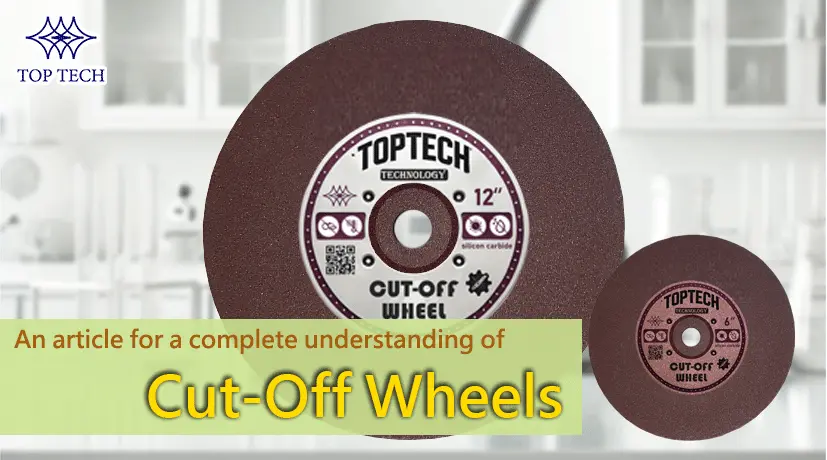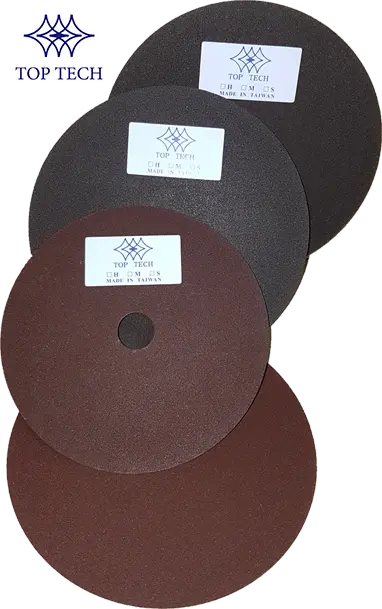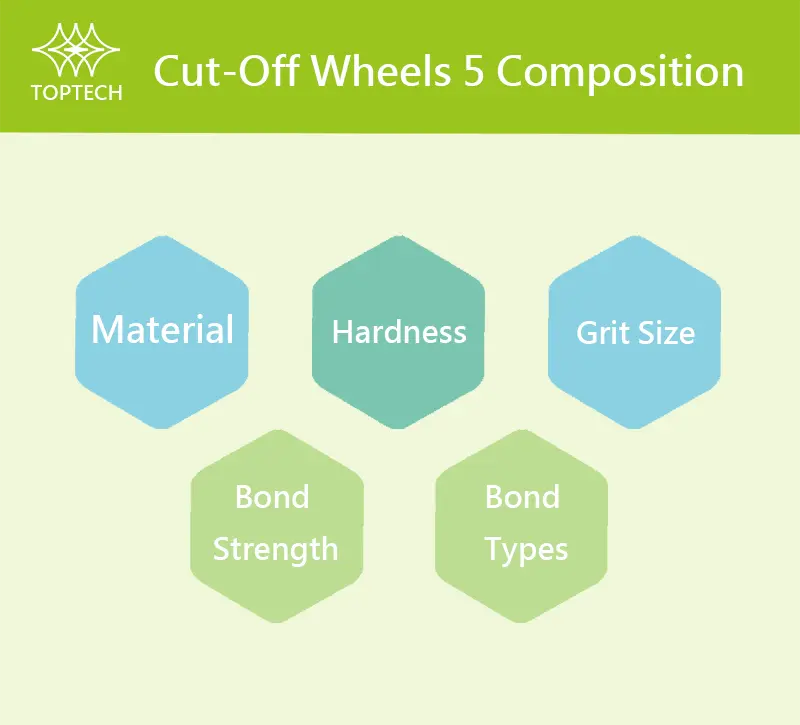
- 1. General Definition of Cut-Off Wheels
- 2. Composition of Cut-Off Wheels
- 3. Advantages and Disadvantages of Cut-Off Wheels
- 4. Usage and Maintenance Considerations for Cut-Off Wheels
- 5. Application Fields of Cut-Off Wheels
Item 1. Cut-Off Wheels Introduction
1. Introduction to Cut-Off Wheels
Cut-off wheels are made from special materials (aluminum oxide or silicon carbide), with varying grit sizes (#10 to over #4000), different bond strengths, and various organic binders. They are primarily used for cutting, grooving, and grinding. Typically, they perform narrow and precise cuts at a 90-degree angle, quickly working on materials such as metal, plastic, concrete, and stone.
Cut-off wheels are blades used in material inspection equipment for industries such as semiconductors, electronic components, aerospace, and more. These wheels maintain high precision and a flat cutting surface during the cutting process, thereby minimizing sample damage and ensuring the accuracy of subsequent microscopic analysis.
The key focus in designing cut-off wheels is to deliver accurate cutting results while preserving the structural integrity of the sample. The material and grit size of the wheels are selected based on the material characteristics and cutting requirements, achieving efficient, stable, and precise cutting. Different materials for cut-off wheels (e.g., Aluminum Oxide Blades and Silicon Carbide Blades) are suitable for samples with varying hardness, making cut-off wheels an essential tool in material research and industrial applications.

2. Importance and Applications of Cut-Off Wheels
Certain specialized cut-off wheels can effectively reduce the thermal impact generated during cutting, such as disk-shaped wheels. This feature is particularly crucial for heat-sensitive materials like quenched steels or composite materials, which may deform, experience hardness reduction, or undergo microstructural changes when excessively heated. However, most cut-off wheels require the use of cutting fluid to achieve cooling effects.
Additionally, cut-off wheels provide smooth and flat surfaces post-cutting, reducing the need for subsequent grinding and polishing steps, thereby streamlining the sample preparation process. This not only saves time and resources but also lowers the risk of sample damage due to excessive handling.
In high-precision research, the cutting results directly influence the final observation outcomes, making the selection and use of cut-off wheels a core aspect of sample testing.
3. Cutting Principles of Cut-Off Wheels
The cutting process of cut-off wheels relies on the abrasive wear action of the wheel surface. When the wheel rotates and contacts the sample, the abrasive grains continuously generate friction and cutting action on the sample surface, removing material layer by layer to form a flat cutting surface. Both the cut-off wheel and the sample wear down simultaneously during the cutting process. The hardness and toughness of different materials determine the wear rate and cutting performance.
(1) Cutting High-Hardness Materials
When the sample has high hardness (e.g., alloy steels, tool steels), the wear on the cut-off wheel is faster. In such cases, a wheel with a softer bond should be selected to allow worn abrasives to detach quickly, exposing new abrasive grains to maintain cutting efficiency and quality.
(2) Cutting Low-Hardness Materials
For materials with lower hardness (e.g., aluminum, copper, and other non-ferrous metals), the wear on the cut-off wheel is slower. Therefore, a wheel with a harder bond should be chosen to minimize unnecessary abrasive loss and ensure cutting stability.
This cutting principle emphasizes the importance of selecting cut-off wheels based on the material's hardness, toughness, and requirements for the cutting surface. Choosing the right cut-off wheel can significantly improve cutting results, protect the sample's structure, and extend the service life of the cut-off wheel.
Contact Us / InqquiryItem 2. Cut-Off Wheels Composition
The performance of cut-off wheels largely depends on their composition. Depending on the application, factors such as material composition, grit size, bond strength, and bond type vary. These factors collectively determine the hardness, toughness, wear resistance, and cutting performance of the wheels. To meet diverse metallographic sample preparation needs, the design of the wheels must precisely account for material characteristics to ensure optimal cutting performance and sample integrity.

1. Material Composition
The main components of cut-off wheels determine their hardness, toughness, and applicability. Common materials include Aluminum Oxide Blades and Silicon Carbide Blades, each with distinct properties and applications:
(1) A (Aluminum Oxide Blades)
Composed of 95–97% aluminum oxide with a small amount of TiO₂, these blades offer good toughness and resistance to breakage. They are suitable for cutting general metallic materials like carbon steel, stainless steel, and ordinary alloys. Their toughness ensures stability during cutting and reduces breakage risks, making them ideal for medium-hard materials.
(2) WA (High-Purity Aluminum Oxide Blades)
With aluminum oxide content exceeding 98%, these blades are harder than standard A-type blades but less tough, making them easier to break. They are suited for high-hardness materials such as alloy steel, tool steel, and quenched steel, offering higher precision and reduced wear.
(3) 32A (Premium Aluminum Oxide Blades)
These blades also exceed 98% aluminum oxide but provide a better balance between toughness and hardness compared to WA blades. Their high toughness minimizes the risk of breakage during cutting. They are ideal for heat-treated metal materials, particularly high-hardness samples like stainless steel or nickel-based alloys, requiring precise observation of their microstructure.
(4) GC (Silicon Carbide Blades)
With 99% silicon carbide content, these blades are extremely hard but brittle, making them suitable for non-metallic materials (e.g., glass, ceramics, carbon fiber) and non-ferrous metals (e.g., aluminum and copper). The high hardness and brittleness of silicon carbide make GC blades ideal for cutting hard and brittle materials, delivering precise and smooth cutting surfaces.
Different material compositions ensure that cut-off wheels can meet cutting needs ranging from soft metals to high-hardness brittle materials, enabling operators to select the most suitable blade for various samples.

2. Grit Size
Grit size refers to the size of abrasive particles in the cut-off wheel, directly influencing the roughness and smoothness of the cutting surface. Grit sizes typically range from #10 to #4000, catering to different precision cutting requirements:
(1) Coarse Grit (#10–#100)
Coarse-grit wheels have larger abrasive particles, suitable for rapid cutting of high-hardness materials. While the cutting speed is fast, the surface is rough, ideal for removing bulk material.
(2) Medium Grit (#100–#600)
These are suitable for general metallographic sectioning, providing smooth surfaces and moderate cutting speeds. Grit sizes between #100 and #150 are commonly used in metallographic analysis, balancing efficiency with reduced polishing time.
(3) Fine Grit (#800–#4000)
Fine-grit wheels are used for high-precision cutting, particularly for samples requiring smooth surfaces. They are ideal for precise cutting, such as in electronic components or thin-layer materials. Despite slower cutting speeds, they maximize surface protection.
Choosing the appropriate grit size based on material hardness and cutting needs ensures optimal cutting results. For example, coarse grit is suitable for high-hardness materials, while fine grit is better for soft materials to ensure flatness and observation quality.
3. Bond Strength
Bond strength refers to the force with which the bonding material holds abrasive particles together, determining the wear rate and applicable materials of the cut-off wheel. Bond strength must align with material hardness to ensure stability and efficiency during cutting:
(1) Low Bond Strength
Suitable for high-hardness materials. As abrasives wear down, the bond allows them to detach quickly, exposing fresh abrasives to maintain cutting continuity and stability.
(2) Medium Bond Strength
Ideal for medium-hardness materials, offering stable wear rates. Medium bonds balance hardness and abrasive retention, meeting most metallographic cutting needs.
(3) High Bond Strength
Suitable for low-hardness materials, as abrasive wear is slower and frequent replacement is unnecessary. High bond strength ensures abrasive retention and is ideal for stable cutting requirements, extending the lifespan of the cut-off wheel. Selecting the right bond strength ensures optimal cutting results, extends cut-off wheel life, and reduces wear during the cutting process.
4. Bond Types
The bond material that holds abrasive particles together affects the rigidity, toughness, and heat dissipation of the cut-off wheel. Common bond types include ceramic, resin, electroplated, and metal, each with distinct features and applications:
(1) Ceramic Bond
Ceramic bonds provide good rigidity and high-temperature resistance, with small pores aiding heat dissipation. They are ideal for high-precision cutting, particularly for high-rigidity, low-temperature applications, such as cutting high-hardness metals.
(2) Resin Bond
Resin bonds offer flexibility and excellent grinding performance, delivering superior cutting surfaces. These wheels are suitable for smooth-surface cutting, such as high-hardness steels. The elasticity of resin bonds minimizes debris during cutting, making them ideal for precision machining.
(3) Electroplated Bond
Electroplated wheels have high abrasive density and wear resistance, suitable for long continuous use. They provide excellent grinding performance and slow wear, making them ideal for cutting complex shapes and high-wear applications, such as hard alloys.
(4) Metal Bond
Metal bonds offer strong shape retention but lower grinding efficiency. They are suitable for precise cutting where shape stability is critical, such as cutting hard and brittle materials. The rigidity of metal bonds ensures cutting stability over extended periods.
Adjusting the bond type based on processing needs and material characteristics ensures stability and durability of cut-off wheels in different application environments.
Contact Us / InqquiryItem 3. Cut-Off Wheels Advantages and Disadvantages
Cut-Off Wheels are widely used in the fields of material science and metallography, offering significant advantages while also presenting some considerations. A thorough understanding of these pros and cons can help make better decisions when selecting and using cut-off wheels, improving cutting efficiency and sample quality.
1. Advantages of Cut-Off Wheels
(1) High Surface Precision
Cut-Off Wheels are specially designed to provide extremely high precision during the cutting process. This high-precision cutting minimizes sample damage and preserves the microstructure, resulting in more accurate observation outcomes.
(2) Reduced Need for Subsequent Grinding and Polishing
As cut-off wheels can produce relatively smooth cutting surfaces, the time and effort required for subsequent grinding and polishing are significantly reduced. The flatness of the cutting surface directly impacts the efficiency of subsequent processing—smoother surfaces require less grinding time, saving labor and consumables.
(3) Diverse Materials, Wide Applicability
The diverse material options for cut-off wheels, such as Aluminum Oxide Blades and Silicon Carbide Blades, cater to the needs of samples with different hardness and materials. For instance, Aluminum Oxide Blades are suitable for general metallic materials, while Silicon Carbide Blades are ideal for non-metallic or soft materials. This versatility enhances the flexibility of cut-off wheels in both laboratory and industrial applications.
(4) High Operational Stability
High-quality cut-off wheels maintain exceptional stability during cutting, which is critical for precise sample sectioning. This stability not only enhances operational safety but also reduces the risk of material displacement or breakage, especially when cutting thin or brittle samples. Stable operation improves cutting precision, resulting in smoother cutting surfaces.
2. Disadvantages of Cut-Off Wheels
(1) High Dependence on Material Selection
The effectiveness of cut-off wheels depends on selecting the appropriate type based on the sample material. Different materials require different specifications of cut-off wheels; improper selection may result in poor cutting performance or sample damage.
During the cutting of high-hardness materials, cut-off wheels typically experience faster wear, particularly when the material hardness exceeds the wheel's capacity. This increases wear and reduces cutting efficiency. Operators must regularly inspect and replace cut-off wheels to maintain cutting quality. Frequent replacements not only increase operational complexity but may also affect the long-term durability of equipment.
(2) Fragility and Risk of Damage
Some less-tough cut-off wheels, especially high-hardness Aluminum Oxide Blades and Silicon Carbide Blades, are prone to breakage under excessive cutting pressure or improper operation.
Contact Us / InqquiryItem 4. Cut-Off Wheels Usage and Maintenance Considerations
The use of cut-off wheels must strictly adhere to operational guidelines to ensure cutting stability and safety. Additionally, the storage environment, operational techniques, and regular inspection and maintenance of cut-off wheels directly affect their lifespan and cutting performance. Understanding these considerations can effectively extend the life of cut-off wheels and mitigate risks during use.
1. Proper Usage Methods
When using cut-off wheels for cutting, the cutting speed should be set according to the material of the wheel and the sample's characteristics. Specific operational recommendations include:
(1) Securing the Cut-Off Wheel
After installing the cut-off wheel, ensure that the cutter's securing nuts and flanges are firmly tightened to prevent the wheel from wobbling or detaching during the cutting process.
(2) Adjusting Cutting Speed
Cutting speed should match the characteristics of the cut-off wheel and the material. For high-hardness samples, it is recommended to use low-speed cutting to reduce wheel wear and minimize heat generation. For low-hardness materials, increasing the cutting speed appropriately can enhance operational efficiency.
(3) Using Coolant
During the cutting process, especially with high-hardness materials, cutting heat can accumulate rapidly, potentially causing deformation or damage to the sample. Proper use of coolant can effectively reduce frictional heat, protect the sample's microstructure integrity, and extend the lifespan of the cut-off wheel.
2. Storage Environment Requirements
The storage conditions of cut-off wheels impact the strength of the bonding agent and their overall performance. Proper storage practices help mitigate the influence of environmental factors. Specific storage recommendations include:
(1) Dry Environment
Cut-off wheels should be stored in a dry space to avoid moisture. Humidity can damage the bonding agent, affecting the abrasive retention and leading to unstable cutting.
(2) Avoiding Direct Sunlight
Direct sunlight may cause material aging in cut-off wheels, particularly making the bonding agent brittle or deformed under prolonged UV exposure. Therefore, cut-off wheels should be stored in a shaded area away from direct sunlight.
(3) Keeping Away from High Temperatures
High temperatures can affect the chemical stability of the bonding agent, altering its hardness. Store cut-off wheels in a room-temperature environment and away from heat sources such as heaters or heating equipment to maintain stable performance.
(4) Vertical Placement
Cut-off wheels should ideally be stored vertically rather than stacked flat to prevent deformation. This is especially important for thicker wheels, as prolonged flat storage can cause gravity-induced deformation, impacting cutting performance.
Contact Us / InqquiryItem 5. Cut-Off Wheels Application Fields
Cut-Off Wheels are widely used across various industries. Each industry has distinct requirements for material cutting, leading to diverse performance demands on the wheels. By selecting the appropriate cut-off wheels, cutting needs can be met for applications ranging from electronics to aerospace.
1. Semiconductor Industry
In the semiconductor industry, cutting materials requires extremely high precision and stability to ensure that delicate circuits and components remain unaffected. Cut-off wheels are primarily used for cutting wafers, ceramic substrates, and other precision components.
(1) Wafer Cutting
Wafer manufacturing demands high stability and precision from cut-off wheels. High-precision Diamond Blades are commonly used to flatten wafer surfaces, ensuring accuracy and reliability for subsequent processes.
(2) Ceramic Substrate Cutting
Semiconductor substrates and packaging materials are often made of ceramic, which is hard and brittle. To prevent cracks during cutting, Silicon Carbide Blades (GC) are typically used. These blades are ideal for cutting high-hardness brittle materials, providing smooth surfaces and reducing cracks to maintain substrate stability.
2. Electronics Industry
In the electronics industry, cut-off wheels are mainly used for cutting precision components and substrate materials, with widespread application in printed circuit board (PCB) cutting.
PCBs, extensively used in electronic products, require precise cutting to ensure that both substrate layers and conductive layers remain intact. Since PCBs are often made of composite materials such as fiberglass and copper foil, which exhibit certain hardness and brittleness, Silicon Carbide Blades (GC) are commonly employed.
3. Aerospace
The aerospace sector has stringent performance requirements for materials, particularly in cutting heat-resistant alloys and stainless steel. These high-strength metallic materials demand cut-off wheels with exceptional hardness and precision.
(1) Stainless Steel Materials
Stainless steel is widely used in aerospace structural components due to its corrosion resistance and high strength. Its high hardness necessitates the use of High-Purity Aluminum Oxide Blades (WA) during cutting. These blades provide both the hardness and surface smoothness required for subsequent material performance analysis.
(2) Nickel-Based Alloys
Known for their excellent high-temperature resistance, nickel-based alloys are often used in aerospace engine manufacturing. Cutting these materials requires crack- and deformation-free surfaces. Premium Aluminum Oxide Blades (32A) are typically chosen for their balanced hardness and toughness, enabling precise and stable cutting suitable for observing microstructures.
4. Automotive Manufacturing
In the automotive industry, cut-off wheels are primarily used for cutting engine components and structural parts. These materials, often a combination of steel and composites, demand high wear resistance and cutting precision from cut-off wheels.
(1) Crankshaft Cutting
Crankshafts, critical engine components, are typically made of quenched alloy steel with very high hardness. For cutting crankshaft samples during analysis, Premium Aluminum Oxide Blades (32A) are commonly used. These blades are capable of handling the high strength of quenched steel while providing smooth cutting surfaces for structural and performance observation.
(2) Oil Seal Cross-Section Observation
Oil seals, composed of rubber exteriors and metal interiors, are used for sealing hydraulic systems and preventing liquid leakage. Due to the differing hardness and toughness of the materials, Silicon Carbide Blades (GC) are suitable for meeting the cutting requirements of layers with varying hardness.
Cut-Off Wheels play an irreplaceable role in metallographic analysis, quality control, and material research. As industrial demands evolve, cut-off wheels have transcended their traditional role as cutting tools to become precision sample preparation equipment. Through high-precision and versatile cutting capabilities, cut-off wheels enable reliable and stable sample preparation, ensuring accurate microstructural observations and material performance analyses.
Contact Us / InqquiryRecommended Reading
▉▎Metallographic Preparation Steps 2025|Got it in 3 minutes!
▉▎Metallographic Cutting Selecting 2025|5 Key Considerations
▉▎Metallographic Mounting Selecting 2025|5 Key Considerations
▉▎Metallographic Grinding and Polishing Selecting 2025|5 Key Consideration
Recommended Products
▉▎Highly Favored by Government and Academic Institutions, Achieving Precision of Up to 0.01mm! (CLM50)
▉▎Fully Automatic Mounting Press: The Top Choice for Research and Quality Control. (ML-L1A)
